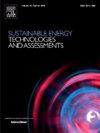P2H系统柔性负荷氢基可持续能源网非线性动力学控制策略
IF 7
2区 工程技术
Q1 ENERGY & FUELS
Sustainable Energy Technologies and Assessments
Pub Date : 2025-05-28
DOI:10.1016/j.seta.2025.104361
引用次数: 0
摘要
在离网直流制氢系统中,光伏(PV)的可变性经常导致源负荷不匹配,导致质子交换膜电解槽(PEMEL)输入电流纹波过大,影响制氢安全。虽然PEMEL的灵活负载特性可以通过跟踪PV波动来稳定运行,但PEMEL分支与输入-串联-输出-并联双有源桥(ISOP-DAB)转换器耦合的非线性动力学和时滞效应给控制带来了重大挑战。三相移(TPS)调制中的无约束电压比加剧了PEMEL-ISOP-DAB等效负载- pv失配。因此,我们提出了一种基于扩展状态观测器(ESO)的柔性负载自抗扰控制(ADRC)策略,该策略采用三层控制框架。第一层通过电压共享控制确保转换器子模块之间的功率平衡。第二层使用拉格朗日乘法器优化算法最小化变换器电流应力。第三层实现了基于eso的终端滑模控制(TSMC)策略,动态调整电解槽的等效负载和匹配PV输出,从而减少电解槽输入电流纹波。与传统的PI控制相比,该策略将稳态电流纹波减少了84.66%,将阶跃变化引起的纹波减少了97.36%,提高了PEMEL的安全性,而无需进行复杂的硬件修改。它的分层控制框架可以直接集成到现有的光伏氢系统中,以提高操作安全性和氢气产量。本文章由计算机程序翻译,如有差异,请以英文原文为准。
Nonlinear dynamics-based control strategy for hydrogen-based sustainable energy grid with flexible load of P2H system
In off-grid DC hydrogen production systems, photovoltaic (PV) variability often leads to source-load mismatches, resulting in excessive proton exchange membrane electrolyzer (PEMEL) input current ripple and compromising hydrogen production safety. While PEMEL’s flexible load characteristics can stabilize operations by tracking PV fluctuations, the nonlinear dynamics and time-delay effects of the PEMEL branch coupled with an input-series output-parallel dual active bridge (ISOP-DAB) converter present significant control challenges. Unconstrained voltage ratios in triple-phase-shift (TPS) modulation exacerbate PEMEL-ISOP-DAB equivalent load-PV mismatch. Thus, we propose an extended state observer (ESO)-based flexible load active disturbance rejection control (ADRC) strategy, which employs a three-tier control framework. The first tier ensures power balance across converter submodules through voltage sharing control. The second tier minimizes converter current stress using a Lagrange multiplier optimization algorithm. The third tier implements an ESO-based terminal sliding mode control (TSMC) strategy to dynamically adjust the electrolyzer’s equivalent load and match PV output, thereby reducing electrolyzer input current ripple. Compared to conventional PI control, the strategy reduces steady-state current ripple by 84.66 % and step-change-induced ripple by 97.36 %, enhancing PEMEL safety without requiring complex hardware modifications. Its hierarchical control framework can be directly integrated into existing photovoltaic-hydrogen systems to enhance operational safety and hydrogen yield.
求助全文
通过发布文献求助,成功后即可免费获取论文全文。
去求助
来源期刊

Sustainable Energy Technologies and Assessments
Energy-Renewable Energy, Sustainability and the Environment
CiteScore
12.70
自引率
12.50%
发文量
1091
期刊介绍:
Encouraging a transition to a sustainable energy future is imperative for our world. Technologies that enable this shift in various sectors like transportation, heating, and power systems are of utmost importance. Sustainable Energy Technologies and Assessments welcomes papers focusing on a range of aspects and levels of technological advancements in energy generation and utilization. The aim is to reduce the negative environmental impact associated with energy production and consumption, spanning from laboratory experiments to real-world applications in the commercial sector.
 求助内容:
求助内容: 应助结果提醒方式:
应助结果提醒方式:


